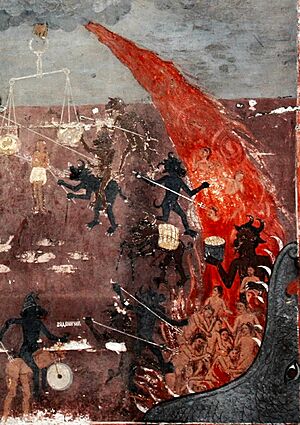Hell facts for kids

In many religions and old stories, Hell is believed to be a place where the souls of people who have done bad things go after they die. It's often seen as the opposite of Heaven, which is usually described as a beautiful and peaceful place. Many beliefs describe Hell as a place without love. In the Bible, the word "Hell" comes from older words like Sheol (Hebrew for "the grave") and Hades or Gehenna (Greek words).
Contents
Jewish Beliefs About Hell
Many people think that Jews do not believe in Hell, but they do. However, Jewish beliefs about Hell are different from some others. They do not believe it is a place of never-ending torture. Instead, they believe there are different levels of Heaven. A person's soul might go to a lower level depending on how many mitzvot (commandments) they followed.
Writings in the Talmud mention ideas about devils, but these are often seen as stories and not taken too seriously. Jews also believe that Satan was an angel who disagreed with God, as told in the story of Job. The Hebrew word Sheol, meaning "the grave," is used for where people go when they die. Some scholars think the idea of Hell as a place of suffering after death might come from a misunderstanding of this word.
Christian Beliefs About Hell
In Christianity, Hell is usually seen as the place where the souls of people go if they have broken important rules set by God. In Hell, souls are believed to suffer and wait for the Last Judgement. This is a time when God will judge the souls of everyone who has died.
The idea of Hell in Christianity comes from the Bible and the story of Lucifer being "cast out" from God's presence. So, for Christians, being separated from God is like being in Hell. Some Christians believe Hell has real fire and flames, while others see it as a spiritual separation.
Many Christian groups believe that once a soul goes to Hell, it stays there forever. But some groups think Hell is only a temporary place, and souls might leave it eventually. Other Christians believe in a permanent Hell but a temporary Purgatory. There are also Christians called annihilationists who believe that those who do not go to Heaven simply stop existing instead of going to Hell.
Other Religions' Beliefs About Hell
- The Ancient Greeks believed that souls went to different places in the Greek underworld. One of these places, called Tartaros, was similar to Hell. The god Hades ruled this underworld.
- In Buddhism, there are three types of hells, known as Naraka. Unlike in Judaism and Christianity, souls are born into these places based on their karma (the good or bad actions they did). They stay there for a certain time and then are reborn somewhere else.
- In Islam, Hell is called Jahannam. It is a place of punishment. However, some Muslims believe that almost everyone will eventually be forgiven and go to the Islamic Heaven (Jannah). The only people who might not be forgiven are those who choose to believe in many gods, or no god at all.
- In Shintoism, Hell (Yomi) is similar to the Greek Hades. All souls go there, no matter what they did in life. They are believed to have a sad existence there forever.
Related Pages
Images for kids
-
Preserved colonial wall painting of 1802 depicting Hell, by Tadeo Escalante, inside the Church of San Juan Bautista in Huaro, Peru
-
In this ~1275 BC Book of the Dead scene, the dead scribe Hunefer's heart is weighed against the feather of truth. If his heart is lighter, he goes to the afterlife. If not, he is eaten by the crocodile-headed Ammit.
-
"Gehenna", Valley of Hinnom, 2007
-
The parable of the Rich man and Lazarus showing the rich man in hell asking for help from Abraham and Lazarus in heaven by James Tissot
-
Yama's Court and Hell. The blue figure is Yamaraja (the Hindu god of death) with his consort Yami and Chitragupta. This is a 17th-century painting.
See also
 In Spanish: Infierno para niños
In Spanish: Infierno para niños









